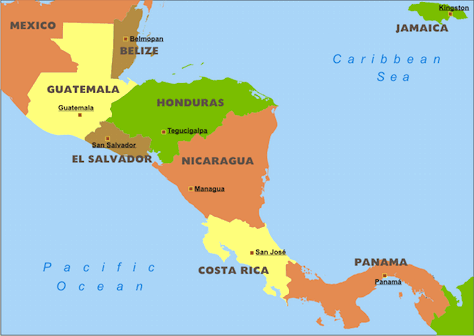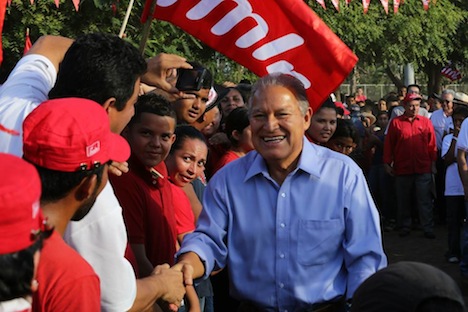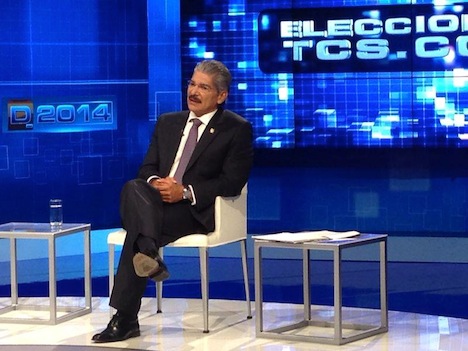
In the same week that conservative Juan Orlando Hernández was inaugurated as Honduras’s new president, both neighboring El Salvador and Costa Rica will vote for new presidents on Sunday, February 2, capping a whirlwind of electoral action that will continue with expected runoffs in both countries throughout the spring and the May Panamanian presidential election.![]()
El Salvador, which lies chiefly along the Pacific coast of Central America, has less than 20% of the area of its neighbor Honduras, but it has 6.3 million residents, nearly 80% of Honduras’s population. That makes El Salvador the densest country, population-wise, on the Latin American mainland, and that’s not counting between 1.65 million and 2 million Salvadoran Americans, many of whom emigrated north during the Salvadoran civil war and whose remittances back to El Salvador account for 28.2% of El Salvador’s gross domestic product. Salvadorans abroad, for the first time in Salvadoran political history, will be able to vote in Sunday’s election and the widely expected runoff between the top two finishers on March 9.
Like Honduras (and Costa Rica and Panamá), the Salvadoran president is constitutionally limited to one term in office, which means that the center-left incumbent, Mauricio Funes, is ineligible to run for reelection.
It’s fairly difficult to understand Salvadoran politics without understanding that it’s still in many ways recovering from the brutal civil war from 1979 to 1992 between the US-backed Salvadoran government and the left-wing guerrilla group, the Frente Farabundo Martí para la Liberación Nacional (FMLN, Farabundo Martí National Liberation Front) that killed between 70,000 and 80,000 people.
The conservative Alianza Republicana Nacionalista (ARENA, Nationalist Republican Alliance) formed in 1981 in direct opposition to the FMLN, and it held power in El Salvador in the early 1980s and again from 1989 until 2009. Under the administration of Alfredo Cristiani, El Salvador finalized the 1992 Chapultepec Peace Accords ending the civil war. His successor Armando Calderón Sol worked to restore a sense of normalcy to the country through the end of the 1990s and to spearhead a series of reforms to privatize and liberalize the Salvadoran economy. Francisco Flores, who led El Salvador from 1999 to 2004, continued ARENA’s broad center-right agenda, strongly pushed for the US-Central American Free Trade Agreement (CAFTA) in alliance with US president George W. Bush and oversaw the dollarization of El Salvador’s economy, a policy that remains controversial even today among Salvadoran economists. Flores, however, is under investigation for misuse of public funds and, earlier this week, skipped a congressional hearing on the investigation and is accused of trying to flee the country on Tuesday.
Meanwhile, the FMLN strived throughout the 1990s and 2000s to shed its radical leftist past and is now El Salvador’s chief center-left political party with an orientation that’s more social democratic today than Marxist. Funes’s narrow election victory (with 51.3% of the vote) in March 2009 represented the first non-ARENA government in El Salvador’s post-civil war history. Funes, a former journalist, campaigned on a moderate agenda that largely accepted much of the neoliberal architecture of the Salvadoran economy, including dollarization. But as president, Funes has expanded social welfare benefits — abolishing public health care fees, combatting illiteracy, providing food and clothing to schoolchildren, granting title to disputed land claims, introducing monthly stipends and job training for the poorest Salvadorans, and signing legislation to protect women, sexual minorities and indigenous communities. He’s also oriented El Salvador closer to the Venezuela-led Alianza Bolivariana (ALBA, Bolivarian Alliance) while retaining strong ties with the United States.
Funes, however, has not been so successful in reducing the violent gang-driven crime and drug trafficking that has also afflicted Honduras, Guatemala and México in recent years. Since a truce between the two top Salvadoran gangs, the Mara Salvatrucha (M13) and Barrio 18, fell through in 2013, Salvador homicides have been on the rise.
The 2014 election pits three candidates against each other, and it’s expected that none will win the absolute majority required to avoid a March runoff. Though polls vary, a January 13 Mitofsky poll shows the ARENA’s candidate, former San Salvador mayor Norman Quijano leads with 35.5%, FMLN’s candidate, vice president Salvador Sánchez Cerén trails narrowly with 31.8% and former president Elías Antonio ‘Tony’ Saca in third place with 16.0%. Other polls in the past two months have shown Sánchez Cerén with as much as a 14% lead, and other polls have shown Saca with up to 27% support, though the trend seems to indicate that Saca’s supporters are partly flocking to Quijano, thereby making the race between Quijano and Sánchez Cerén much tighter.
So how would each of the three candidates govern El Salvador?
Unlike Funes, who was a reporter during the civil war, Sánchez Cerén (pictured above) was a top military leader, and he leans further left than Funes. He was elected to El Salvador’s legislative assembly in 2000, where he served until he became Funes’s running mate in 2009. Sánchez Cerén would likely pull El Salvador even closer to ALBA in terms of regional alliances, including perhaps Salvadoran membership in Venezuela’s subsidized, loan-based Petrocaribe program.
He’s run a ‘tres pilares‘ (three pillars) campaign focused on employment, security and education. Óscar Ortiz, the pragmatic and widely popular mayor of Santa Tecia, and a potential presidential candidate in his own right, is his running mate.
Quijano (pictured above), the ARENA candidate, served most recently as mayor of San Salvador, the country’s capital, between 2009 and 2013. He has himself been investigated for corruption, and his ties to Flores haven’t necessarily reassured Salvadoran voters. Quijano would mark a return to the essentially neoliberal, US-allied standard of El Salvador between 1992 and 2009, as well as a turn away from ALBA, which, as Frederick B. Mills writes for the Council on Hemispheric Affairs, would not necessarily be welcomed by Salvadoran business interests:
Such a move would be controversial, however, because the private sector in El Salvador, regardless of political affiliation, is benefitting from the ALBA relationship.
Quijano has promised to deploy the country’s armed forces to combat gang violence. Quijano would also likely block any moves by the Salvadoran judiciary and Salvadoran civil society to rupture the country’s long-standing civil war amnesty law by bringing war criminals from the 1980s to justice.
Saca (pictured above) is the candidate of the Gran Alianza por la Unidad Nacional (GANA, Grand Alliance for National Unity), which is the largest party in a wider ‘UNIDAD’ coalition and former Salvadoran president. A Palestinean-Salvadoran, Saca was a sports journalist and a businessman before his election as president in 2004. Saca, who generally pursued the same center-right, free-market policies as prior ARENA administrations, was one of the Bush administration’s staunchest allies, going so far to send Salvadoran troops to Iraq. Like Flores and Quijano, he’s been dogged by accusation of corruption. Saca formed GANA in 2009 and, while it’s essentially as conservative as ARENA, his breakaway faction formed a coalition with the ruling FMLN.



One thought on “Three-way Salvadoran presidential election focuses on security”